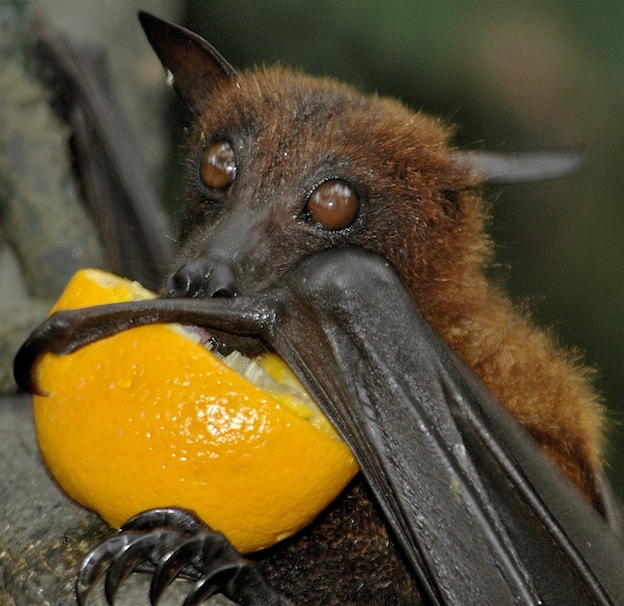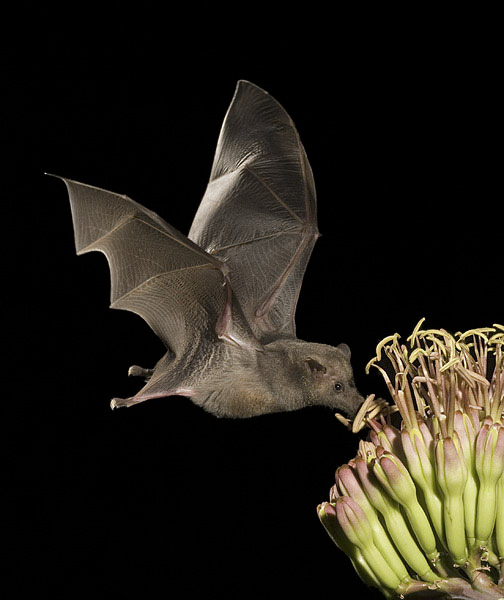Bats and plants clearly share a long history of mutual
interactions and therefore exhibit specialized adaptations in extant species.
These adaptations are evidence for coevolution between bats and plants and have
been crucial to the establishment of pollination mutualisms. However,
deforestation and human activities are threatening the persistence of bat-plant
pollination mutualisms in recent times. In
a land survey experiment, Garcia-Morales et al. (2013) found that all
Neotropical bats responded negatively to human-use landscapes, including urban
areas and monoculture crop fields. While Phyllostomid frugivores responded
positively to agroforestry areas in this study, mainly due to increased fruit
availability, overall bat diversity decreased (Garcia-Morales et al. 2013). The
authors also found that human use areas were particularly detrimental to
specialized nectarivorous bats. Since nectarivorous bats are among the most
important bat pollinators of plants, human-induced land use change could
threaten the persistence of specialized bat-plant pollination mutualisms. Deforestation
is also displacing bat pollinators to edge habitat areas and thus pushing them
farther from their foraging grounds (Kunz and Fenton 2003). By interfering with
the feeding patterns of nectarivorous bats, deforestation may thus result in
decreased pollination efficiencies of these specialists and threaten their
plant hosts by extension. Similatly, Cosson et al. (1999) found that habitat
fragmentation in French Guiana decreased the foraging range of nectarivorous
bats, greatly reducing the chance that specialized nectarivores would visit
their preferred plant host. This could translate into pollination frequency
declines and thus threaten bat-plant pollination mutualisms in the area.
In addition to disrupting
pollination activity, deforestation also threatens ecosystem services that bats
provide including insect control, seed dispersal, and forest regeneration (Kunz
and Fenton 2005). Frugivorous bats are important seed dispersers to many
tropical plant species by increasing regional population size (Becker et al.
2010). By expanding plant species range, bats could potentially be important
agents of promoting forest regeneration in deforested areas; Racey and Swift
(1995) report that seed dispersal patterns vary between bats of different size
categories, families, and feeding behaviors. Therefore, a heterogeneous pattern
of seed dispersal occurs throughout
forests with bat seed dispersers (Racey and Swift 1995).
Future studies should focus
on the patterns of pollination efficiency of bat pollinators in disturbed
habitats. Although the majority of the world’s plants rely on multiple
pollinators for fertilization, there are still highly specialized relationships
between bats and plants that need to be protected. If deforestation continues
at current rates, the pollination mutualisms between bats and plants that have
developed from millions of years of coevolution could vanish in the near
future. In addition, other important ecosystem services provided by bats and
their interactions with plants are at risk. The loss of even a single bat or
plant species could have devastating consequences on an entire ecosystem, as
specialized adaptations between bats and plants have required ideal
circumstances over long periods of time in order to fully develop. These
circumstances may never occur again in our Earth’s history, and therefore
coevolved specialist species like bats and their hosts are important to
conserve.
 |
| Borrow (2008). Little red flying fox (Pteropus scapulatus). |
References
Becker, N.I., Rothenwöhrer, C. & Tschapka, M. 2010, "Dynamic feeding habits: efficiency of frugivory in a nectarivorous bat", Canadian journal of zoology, vol. 88, no. 8, pp. 764-773.
Cosson, J., Pons, J. & Masson, D. 1999, "Effects of Forest Fragmentation on Frugivorous and Nectarivorous Bats in French Guiana", Journal of Tropical Ecology, vol. 15, no. 4, pp. 515-534.
Garcia-Morales, R., Badano E.I. & Moreno, C.E. 2013, "Response of Neotropical Bat Assemblages to Human Land Use", Conservation Biology, vol. 27, no. 5, pp. 1096-1106.
Kunz, T.H. & Fenton, M.B. 2003, Bat ecology, Paperback edn, University of Chicago Press, Chicago.
Racey, P.A., Swift, S.M., Zoological Society of London & Mammal Society 1995, Ecology, evolution and behaviour of bats :the proceedings of a symposium held by the Zoological Society of London and the Mammal Society : London, 26th and 27th November 1993, Published for the Zoological Society of London by Clarendon Press, Oxford.










 Figure 1. Cooper, M. 2006. A tube-lipped nectar bat (Anoura fistulata) sips nectar from a tube. Note extreme length of the tongue, which is more than half of the bat's total body length. This adaptation allows for quick and efficient nectar feeding. http://www.newscientist.com/article/dn10721-the-bat-with-the-incredibly-long-tongue.html; retrieved 29/3/2015.
Figure 1. Cooper, M. 2006. A tube-lipped nectar bat (Anoura fistulata) sips nectar from a tube. Note extreme length of the tongue, which is more than half of the bat's total body length. This adaptation allows for quick and efficient nectar feeding. http://www.newscientist.com/article/dn10721-the-bat-with-the-incredibly-long-tongue.html; retrieved 29/3/2015.



